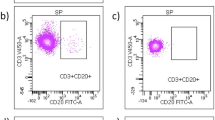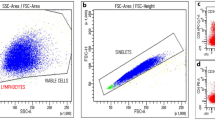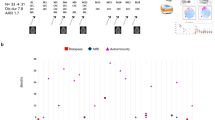Abstract
Background
Natalizumab is an effective therapy in the treatment of relapsing-remitting multiple sclerosis; it induces lymphocytosis (NIL, natalizumab-induced lymphocytosis) and changes the peripheral lymphocyte pattern.
Methods
This study aims to evaluate NIL, peripheral blood lymphocyte subsets, CD4/CD8 ratio, and their impacts on JCV index and clinical data—No Evidence of Disease Activity (NEDA-3) and annualized relapse rate (ARR) in patients treated with natalizumab.
Results
Forty-one patients (33 women) were included in the study. The mean duration of follow-up on natalizumab treatment was 6.7 ± 3.2 years. Significant increases in relative lymphocytosis after 1 month, with a median of 40.4% (− 34.1 to + 145.5%) (p < 0.001), and after 1 year (49.0% (− 9.3 to + 127.6%)) (p < 0.001) were found. Significant differences were found after 1 month when comparing NIL between patients JCV-seroconverting (20.6% (− 17.7 to 72.7%)) and stable JCV-seronegative ones (43.5% (− 6.3 to +96.3%)) (p = 0.04). No significant difference NIL level was found between the patients exhibiting NEDA-3 status and those without it. ARR on natalizumab treatment correlated with CD4/CD8 ratio (r = 0.356; p = 0.021); patients who maintained NEDA-3 status over the whole treatment period exhibited a lower CD4/CD8 ratio (1.89 ± 1.08 vs. 2.5 ± 0.73; p < 0.04).
Conclusion
This contribution reports the CD4/CD8 ratio as a possible biomarker for better clinical efficacy of natalizumab in patients exhibiting a lower CD4/CD8 ratio. NIL did not correlate with long-term therapeutic efficacy in patients treated with natalizumab, but was demonstrated as lower in patients JCV-seroconverting in the course of follow-up.


Similar content being viewed by others
References
Butzkueven H, Kappos L, Pellegrini F, Trojano M, Wiendl H, Patel RN, Zhang A, Hotermans C, Belachew S, on behalf of the TYSABRI Observational Program (TOP) Investigators (2014) Efficacy and safety of natalizumab in multiple sclerosis: interim observational programme results. J Neurol Neurosurg Psychiatry 85:1190–1197. https://doi.org/10.1136/jnnp-2013-306936
Puthenparampil M, Cazzola C, Zywicki S et al (2018) NEDA-3 status including cortical lesions in the comparative evaluation of natalizumab versus fingolimod efficacy in multiple sclerosis: therapeutic advances in neurological disorders. https://doi.org/10.1177/1756286418805713
Engelhardt B, Kappos L (2008) Natalizumab: targeting α4-integrins in multiple sclerosis. NDD 5:16–22. https://doi.org/10.1159/000109933
Camponeschi A, Gerasimcik N, Wang Y, Fredriksson T, Chen D, Farroni C, Thorarinsdottir K, Sjökvist Ottsjö L, Aranburu A, Cardell S, Carsetti R, Gjertsson I, Mårtensson IL, Grimsholm O (2019) Dissecting integrin expression and function on memory B cells in mice and humans in autoimmunity. Front Immunol 10. https://doi.org/10.3389/fimmu.2019.00534
Kim TK, Billard MJ, Wieder ED, McIntyre BW, Komanduri KV (2010) Co-engagement of α4β1 integrin (VLA-4) and CD4 or CD8 is necessary to induce maximal Erk1/2 phosphorylation and cytokine production in human T cells. Hum Immunol 71:23–28. https://doi.org/10.1016/j.humimm.2009.09.360
Frisullo G, Iorio R, Plantone D, Marti A, Nociti V, Patanella AK, Batocchi AP (2011) CD4+T-bet+, CD4+pSTAT3+ and CD8+T-bet+ T cells accumulate in peripheral blood during NZB treatment. Mult Scler 17:556–566. https://doi.org/10.1177/1352458510392263
Neumann F, Zohren F, Haas R (2009) The role of natalizumab in hematopoietic stem cell mobilization. Expert Opin Biol Ther 9:1099–1106. https://doi.org/10.1517/14712590903055011
Signoriello E, Lanzillo R, Morra VB et al (2015) Lymphocytosis as a response biomarker of natalizumab therapeutic efficacy in multiple sclerosis. Mult Scler J. https://doi.org/10.1177/1352458515604381
Bloomgren G, Richman S, Hotermans C, Subramanyam M, Goelz S, Natarajan A, Lee S, Plavina T, Scanlon JV, Sandrock A, Bozic C (2012) Risk of natalizumab-associated progressive multifocal leukoencephalopathy. N Engl J Med 366:1870–1880. https://doi.org/10.1056/NEJMoa1107829
Ferenczy MW, Marshall LJ, Nelson CDS, Atwood WJ, Nath A, Khalili K, Major EO (2012) Molecular biology, epidemiology, and pathogenesis of progressive multifocal leukoencephalopathy, the JC virus-induced demyelinating disease of the human brain. Clin Microbiol Rev 25:471–506. https://doi.org/10.1128/CMR.05031-11
McGuigan C, Craner M, Guadagno J, Kapoor R, Mazibrada G, Molyneux P, Nicholas R, Palace J, Pearson OR, Rog D, Young CA (2016) Stratification and monitoring of natalizumab-associated progressive multifocal leukoencephalopathy risk: recommendations from an expert group. J Neurol Neurosurg Psychiatry 87:117–125. https://doi.org/10.1136/jnnp-2015-311100
Olsson T, Achiron A, Alfredsson L et al (2013) Anti-JC virus antibody prevalence in a multinational multiple sclerosis cohort. Mult Scler J. https://doi.org/10.1177/1352458513477925
Tan CS, Koralnik IJ (2010) Progressive multifocal leukoencephalopathy and other disorders caused by JC virus: clinical features and pathogenesis. Lancet Neurol 9:425–437. https://doi.org/10.1016/S1474-4422(10)70040-5
Gorelik L, Lerner M, Bixler S, Crossman M, Schlain B, Simon K, Pace A, Cheung A, Chen LL, Berman M, Zein F, Wilson E, Yednock T, Sandrock A, Goelz SE, Subramanyam M (2010) Anti-JC virus antibodies: implications for PML risk stratification. Ann Neurol 68:295–303. https://doi.org/10.1002/ana.22128
Aladro Y, Terrero R, Cerezo M, Ginestal R, Ayuso L, Meca-Lallana V, Millán J, Borrego L, Martinez-Ginés M, Rubio L, de Andrés C, Miralles A, Guijarro C, Rodríguez-García E, García-Dominguez JM, Muñoz-Fernández C, López de Silanes C, Gómez M, Thuissard I, Cerdán M, Palmí I, Díaz-Garzón LF, Meca-Lallana J (2016) Anti-JC virus seroprevalence in a Spanish multiple sclerosis cohort: JC virus seroprevalence in Spain. J Neurol Sci 365:16–21. https://doi.org/10.1016/j.jns.2016.03.050
Bozic C, Richman S, Plavina T, Natarajan A, Scanlon JV, Subramanyam M, Sandrock A, Bloomgren G (2011) Anti-John Cunningham virus antibody prevalence in multiple sclerosis patients: baseline results of STRATIFY-1. Ann Neurol 70:742–750. https://doi.org/10.1002/ana.22606
Hegen H, Auer M, Bsteh G, di Pauli F, Plavina T, Walde J, Deisenhammer F, Berger T (2017) Stability and predictive value of anti-JCV antibody index in multiple sclerosis: a 6-year longitudinal study. PLoS One 12:e0174005. https://doi.org/10.1371/journal.pone.0174005
Kolasa M, Hagman S, Verkkoniemi-Ahola A, Airas L, Koivisto K, Elovaara I (2016) Anti-JC virus seroprevalence in a Finnish MS cohort. Acta Neurol Scand 133:391–397. https://doi.org/10.1111/ane.12475
Kolcava J, Hulova M, Benesova Y, Bednarik J, Stourac P (2019) The value of anti-JCV antibody index assessment in multiple sclerosis patients treated with natalizumab with respect to demographic, clinical and radiological findings. Mult Scler Relat Disord 30:187–191. https://doi.org/10.1016/j.msard.2019.02.019
Outteryck O, Zéphir H, Salleron J et al (2013) JC-virus seroconversion in multiple sclerosis patients receiving natalizumab. Mult Scler J. https://doi.org/10.1177/1352458513505353
Vennegoor A, van Rossum JA, Leurs C, Wattjes MP, Rispens T, Murk JLAN, Uitdehaag BMJ, Killestein J (2016) High cumulative JC virus seroconversion rate during long-term use of natalizumab. Eur J Neurol 23:1079–1085. https://doi.org/10.1111/ene.12988
Iannetta M, Zingaropoli MA, Bellizzi A, Morreale M, Pontecorvo S, D’Abramo A, Oliva A, Anzivino E, Lo Menzo S, D’Agostino C, Mastroianni CM, Millefiorini E, Pietropaolo V, Francia A, Vullo V, Ciardi MR (2016) Natalizumab affects T-cell phenotype in multiple sclerosis: implications for JCV reactivation. PLoS One 11:e0160277. https://doi.org/10.1371/journal.pone.0160277
Koudriavtseva T, Sbardella E, Trento E, Bordignon V, D'Agosto G, Cordiali-Fei P (2014) Long-term follow-up of peripheral lymphocyte subsets in a cohort of multiple sclerosis patients treated with natalizumab. Clin Exp Immunol 176:320–326. https://doi.org/10.1111/cei.12261
Stüve O, Marra CM, Jerome KR et al (2006) Immune surveillance in multiple sclerosis patients treated with natalizumab. Ann Neurol 59:743–747. https://doi.org/10.1002/ana.20858
Warnke C, Stettner M, Lehmensiek V et al (2014) Natalizumab exerts a suppressive effect on surrogates of B cell function in blood and CSF. Mult Scler J. https://doi.org/10.1177/1352458514556296
Thompson AJ, Banwell BL, Barkhof F, Carroll WM, Coetzee T, Comi G, Correale J, Fazekas F, Filippi M, Freedman MS, Fujihara K, Galetta SL, Hartung HP, Kappos L, Lublin FD, Marrie RA, Miller AE, Miller DH, Montalban X, Mowry EM, Sorensen PS, Tintoré M, Traboulsee AL, Trojano M, Uitdehaag BMJ, Vukusic S, Waubant E, Weinshenker BG, Reingold SC, Cohen JA (2018) Diagnosis of multiple sclerosis: 2017 revisions of the McDonald criteria. Lancet Neurol 17:162–173. https://doi.org/10.1016/S1474-4422(17)30470-2
Kister I, Kuesters G, Chamot E, Omari M, Dontas K, Yarussi M, Subramanyam M, Herbert J (2014) IV immunoglobulin confounds JC virus antibody serostatus determination. Neurol Neuroimmunol Neuroinflamm 1:e29. https://doi.org/10.1212/NXI.0000000000000029
Lee P, Plavina T, Castro A, Berman M, Jaiswal D, Rivas S, Schlain B, Subramanyam M (2013) A second-generation ELISA (STRATIFY JCV™ DxSelect™) for detection of JC virus antibodies in human serum and plasma to support progressive multifocal leukoencephalopathy risk stratification. J Clin Virol 57:141–146. https://doi.org/10.1016/j.jcv.2013.02.002
Carotenuto A, Scalia G, Ausiello F, Moccia M, Russo CV, Saccà F, de Rosa A, Criscuolo C, del Vecchio L, Brescia Morra V, Lanzillo R (2017) CD4/CD8 ratio during natalizumab treatment in multiple sclerosis patients. J Neuroimmunol 309:47–50. https://doi.org/10.1016/j.jneuroim.2017.05.006
Sangalli F, Moiola L, Bucello S, Annovazzi P, Rizzo A, Radaelli M, Vitello G, Grimaldi LME, Ghezzi A, Martinelli V, Comi G (2011) Efficacy and tolerability of natalizumab in relapsing-remitting multiple sclerosis patients: a post-marketing observational study. Neurol Sci 31(Suppl 3):299–302. https://doi.org/10.1007/s10072-010-0344-z
Rossi S, Motta C, Studer V, Monteleone F, de Chiara V, Buttari F, Barbieri F, Bernardi G, Battistini L, Cutter G, Stüve O, Salvetti M, Centonze D (2013) A genetic variant of the anti-apoptotic protein Akt predicts natalizumab-induced lymphocytosis and post-natalizumab multiple sclerosis reactivation. Mult Scler 19:59–68. https://doi.org/10.1177/1352458512448106
Acknowledgments
Tony Long (Dalmellington) helped work up the English.
Funding
This work was supported by the Ministry of Health of the Czech Republic, ref. - RVO (FNBr, 65269705), and the project of specific research ref. MUNI/A/1325/2019 from the program of support of student projects at Masaryk University.
Author information
Authors and Affiliations
Corresponding author
Ethics declarations
Conflict of interest
The authors declare that they have no conflict of interest.
Ethics approval
The research was approved by the local ethics committees.
Additional information
Publisher’s note
Springer Nature remains neutral with regard to jurisdictional claims in published maps and institutional affiliations.
Rights and permissions
About this article
Cite this article
Kolcava, J., Hulova, M., Rihova, L. et al. The impact of lymphocytosis and CD4/CD8 ratio on the anti-JCV antibody index and clinical data in patients treated with natalizumab. Neurol Sci 42, 2847–2853 (2021). https://doi.org/10.1007/s10072-020-04897-2
Received:
Accepted:
Published:
Issue Date:
DOI: https://doi.org/10.1007/s10072-020-04897-2




